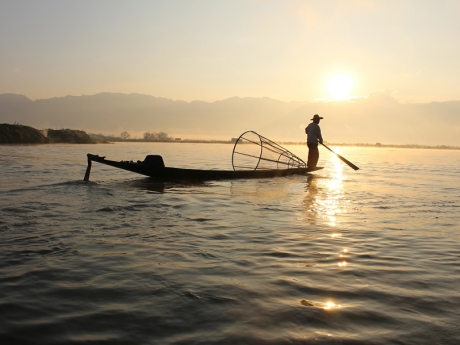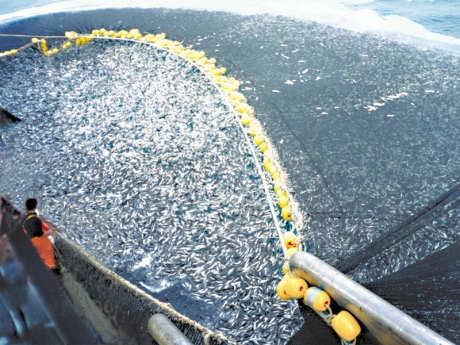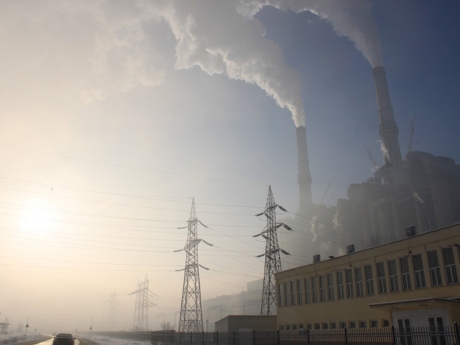Seafood
Background
The wealth of the sea belongs to the dead, the living, and those yet to be born.
– Asian proverb

Fisherman in Myanmar. The cone-shaped net in his boat traps fish.
Throughout history, people have relied on aquatic plants and animals for food, particularly among island and coastal communities. If aquatic species are not overharvested, these resources can be sustained for countless generations.
Photo public domain.
This proverb, common to coastal fishing communities, speaks to the importance of learning from the past (the dead) and conserving ocean resources for future generations (those yet to be born).1
Throughout history, people have relied on aquatic plants and animals for nourishment, particularly among island and coastal communities. For Samoan islanders, sea animals like eels, worms, turtles, and sharks were a central part of traditional diets. Samoan fisherfolk were deeply attuned to their environment, and if they determined a particular species was threatened by overfishing, a village council would put a halt to those activities until it was safe to resume.2
Other cultures found ways to cultivate their own aquatic plants or animals for food—a practice called aquaculture. Ancient Egyptians, for example, built inland ponds and stocked them with fish and plants, while a system of elaborate canals supplied the ponds with fresh water.3
Today, aquatic animals are among the last major food sources still hunted from the wild. Once-plentiful fish populations, however, are threatened by a crisis of overfishing, hastened by industrial methods that operate on an unprecedented scale. With wild species in decline, more and more seafood is farmed, but is aquaculture necessarily a more sustainable alternative?
Wild-Caught Seafood

About 400 tons of mackerel caught in a purse seine (a type of net). Chile.
The vast majority of global seafood harvests use gigantic nets that are pulled through the water at varying depths or along the sea floor.4
Photo credit: C. Ortiz Rojas, NOAA Photo Library.
Many island and coastal communities still rely on traditional fishing tools like spears, rods, traps, and hand-thrown nets. Samoan islanders, for example, even developed a specialized rope noose for snaring sharks.2 The vast majority of global seafood harvests, however, employs gigantic nets that are pulled through the water at varying depths.4
Industrial fishing methods can have devastating effects on aquatic life. Nets often scoop up large numbers of unwanted aquatic animals, called bycatch. Some of these animals are kept for sale, but most are thrown back to the sea, usually dead or dying. Bottom trawling (dragging a net across the sea floor) and dredging (using a large metal basket to scoop up shellfish like scallops, clams, and oysters) are the most damaging in this regard.5 In the shrimp harvesting industry, for example, only 5 percent of what some trawlers catch is actually shrimp, and the rest is bycatch.6 Dragging nets and dredges across the sea floor also destroys fragile sea sponges, corals, and other critical members of ocean ecosystems.5
For many aquatic species, centuries of overfishing—both with traditional and industrial methods—have depleted populations well below historic levels.7 Some species, such as Atlantic salmon, have been nearly eliminated from many of their natural habitats,8 affecting people who depend on those animals for food and livelihoods.
Overfishing is not just the result of harvesting animals for people to eat. In 2010, close to 20 percent of wild-caught seafood was ground into fishmeal and fish oil and fed to farmed animals, including farm-raised fish such as salmon, as well as pigs and chickens.7 Harvesting small wild fish to feed farmed fish can contribute to problems of overfishing, and can deprive wild carnivorous fish of their food sources.9
Aquaculture: Farming Seafood
Aquaculture (farming seafood) is the fastest growing industry in food animal production. Almost half the seafood consumed worldwide is now farm-raised.7
There are many different kinds of aquaculture systems. Some are built inland or along the coast, while others raise animals in the sea. For example:
- Raising animals in ponds is the oldest form of aquaculture. This method is popular in the U.S. for raising catfish.
- Raceways are artificial channels (like lanes of a swimming pool) with a flowing current, which flushes out fish waste.
- Recirculating systems raise fish in filtered tanks. The water is continually cleaned and recycled—just like in an aquarium.
- Marine aquaculture uses cages anchored to the sea floor, or floating nets. This system is often used for salmon.
In some cases, particularly for shellfish (see caption), aquaculture can be a more sustainable alternative to harvesting animals from the wild.
Aquaculture can also contribute to environmental and public health problems. Like industrial hog, poultry, and cattle facilities, aquaculture farms often confine large numbers of fish in a relatively small area—many offshore salmon farms, for example, stock over 300,000 fish at a time.10 The large quantities of waste from these farms can pollute surrounding waters, harming ocean wildlife.9 In such crowded conditions, diseases can spread among fish and into the wild.11 Antibiotics given to fish to compensate for unsanitary conditions can pose human health risks if the drugs remain in the edible parts of fish, or if their use contributes to antibiotic resistance.12 Farmed fish, such as Atlantic salmon, often escape into the wild. Atlantic salmon are larger and more aggressive than their wild cousins, and can outcompete native species, disrupting aquatic food chains.11 Farm-raising fish can also contribute to problems of overfishing.
Seafood in Diets

Emissions from a coal-fired power plant.
Much of the pollution from industrial activity winds up in our streams, rivers, and oceans, where it can accumulate in the tissues of aquatic plants and animals. Globally19 and in the U.S.,20 coal-burning power plants are the largest human-caused source of airborne mercury emissions.
Photo credit: Emilian Vicol. Public domain.
Between 1983 and 2003, total U.S. seafood consumption more than doubled. By 2009, the U.S. was second only to China as the largest seafood consumer in the world.13 On a per capita basis, the typical American eats 30 percent more seafood than the global average,13 yet 2010 U.S. Dietary Guidelines advised Americans to eat even more.14 Is this good advice?
Most fish and shellfish are good sources of nutrients, including vitamins, minerals, protein, and the omega-3 fats EPA and DHA. These fats are crucial for brain and eye development, and studies suggest they may have cardiovascular health benefits.15 Diets with a moderate amount of fatty fish, nuts, and olive oil (the so-called Mediterranean diet) have been shown to protect cardiovascular health, possibly because of the types of fats in these foods.16
There are also potential health risks associated with eating contaminated seafood. Much of the pollution from industrial activity—such as mercury from coal-fired power plants—winds up in our streams, rivers, and oceans, where it can accumulate in the tissues of aquatic plants and animals. Some toxic chemicals, such as the pesticide DDT, are still showing up in seafood long after the pesticides were banned.17 Because concentrations of certain contaminants tend to increase at each level of the food chain, larger carnivorous fish like sharks and swordfish generally pose the greatest risks for seafood consumers.18 Contaminants can also accumulate in the tissues of farm-raised fish that are given feed made with contaminated wild fish.18 See also Food Safety.
Taken together, there are many important health, ecological, and economic considerations when making choices about seafood. For example, consumers may wish to limit their seafood consumption to sustainably-raised or sustainably-harvested species that are lower on the food chain.
Resources
This list is a starting point for further exploration. Some materials may not reflect the views of the Johns Hopkins Center for a Livable Future.
For teachers
- Seafood: Wild and Farmed (lesson plan). FoodSpan. Johns Hopkins Center for a Livable Future.
- Introduction to the US Food System: Public Health, Environment, and Equity (textbook). Neff RN (editor). Johns Hopkins Center for a Livable Future. 2014.
Reports and websites
- U.S. Fish Advice May Expose Babies to Too Much Mercury. Environmental Working Group. 2016.
- The State of World Fisheries and Aquaculture 2014. Food and Agriculture Organization of the United Nations.
- Smart Seafood Guide. Food and Water Watch.
- Start Your Sustainable Seafood Search (website). Monterey Bay Aquarium.
- Recreational fishing advisories map (website). U.S. Environmental Protection Agency.
Videos
- The four fish we're overeating — and what to eat instead. Paul Greenberg. TED. 2015.
Academic journal articles
- Public Health Perspectives on Aquaculture (open access). Gormaz JG, Fry JP, Erazo M, Love DC. Current Environmental Health Reports. 2014.
- A chain of fools: or, why it is so hard to stop overfishing (open access). Boonstra WJ and Österblom H. Maritime Studies. 2014.
- Primary Prevention of Cardiovascular Disease with a Mediterranean Diet (requires subscription). Estruch R, Ros E, et al. The New England Journal of Medicine. 2013.
References
- Kurien J. Traditional Ecological Knowledge and Ecosystem Sustainability: New Meaning to Asian Coastal Proverbs. Ecol Appl. 2014;8(1):S2-S5.
- Armstrong K, Herdrich D, Levine A. Historic Fishing Methods in American Samoa. NOAA; 2011.
- Costa-Pierce BA. Aquaculture in ancient Hawaii. Bioscience. 1987;37(5):320-331.
- Watson R, Revenga C, Kura Y. Fishing gear associated with global marine catches I. Database development. Fish Res. 2006;79(1-2):97-102.
- Watson R, Revenga C, Kura Y. Fishing gear associated with global marine catches II. Trends in trawling and dredging. Fish Res. 2006;79(1-2):103-111.
- Davies RWD, Cripps SJ, Nickson a., Porter G. Defining and estimating global marine fisheries bycatch. Mar Policy. 2009;33(4):661-672.
- U.N. Food & Agriculture Organization. The State of World Fisheries and Aquaculture. Rome; 2012.
- Parrish DL, Behnke RJ, Gephard SR, McCormick SD, Reeves GH. Why aren’t there more Atlantic salmon (Salmo salar)? Can J Fish Aquat Sci. 1998;55(S1):281-287.
- Naylor RL, Goldburg RJ, Primavera JH, et al. Effect of aquaculture on world fish supplies. Nature. 2000;405:1017-1024.
- Milewski I. Bay Management and New Brunswick’s Salmon Aquaculture Industry. 2014.
- Naylor R, Hindar K, Fleming IA, et al. Fugitive salmon: Assessing the risks of escaped fish from net-pen aquaculture. Bioscience. 2005;55(5):427.
- Cabello FC. Heavy use of prophylactic antibiotics in aquaculture: a growing problem for human and animal health and for the environment. Environ Microbiol. 2006;8(7):1137-1144.
- U.N. Food & Agriculture Organization. FAOSTAT. 2013.
- U.S. Department of Health and Human Services, U.S. Department of Agriculture. Dietary Guidelines for Americans, 2010.; 2011.
- Ruxton CHS, Reed SC, Simpson MJ a, Millington KJ. The health benefits of omega-3 polyunsaturated fatty acids: a review of the evidence. J Hum Nutr Diet. 2004;17(5):449-59.
- Estruch R, Ros E, Salas-Salvadó J, et al. Primary prevention of cardiovascular disease with a Mediterranean diet. N Engl J Med. 2013;368(14):1279-90.
- Dougherty C. Dietary Exposures to Food Contaminants across the United States. Environ Res. 2000;84(2):170-185.
- Gormaz J, Fry J, Erazo M, Love D. Public Health Perspectives on Aquaculture. Curr Environ Heal Reports. 2014:1-12.
- UNEP Chemicals Branch. The Global Atmospheric Mercury Assessment: Sources, Emissions and Transport. Geneva, Switzerland; 2008.
- U.S. Environmental Protection Agency. Mercury: Basic Information. 2013.
